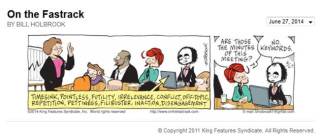Just about a year ago, the Project Management Institute upgraded their Body of Knowledge which describes standards of excellence among project management professionals. A significant addition to the list of effective tools was “meetings”. My first thought was “Yes!! People working together in collaborative environments to resolve problems: Brainstorming – information sharing – Broadening of Perspectives. And then, the reality set in: people scheduling meetings to schedule meetings; leaving us to coming in early and staying late in order to accomplish constructive work.
Below are some suggestions that are fairly easy to implement.
Pre-Plan
- Who needs to be invited?
o Determine the objective of the meeting.
o Invite people who have a direct stake toward achieving the meeting objective
- Who should be copied on the invitation?
o Managers and ancillary support people need to be aware of the meeting and desired outcomes; they may not need to attend.
o It is good to keep them apprised of your progress and they may have suggestions or be able to offer assistance to you.
o Include a preliminary agenda and desired outcomes as part of meeting invitation
o The preliminary agenda offers people the opportunity to prepare to fully participate in the meeting.
o Invite people to request additions to the agenda, as well as share insights that might help you facilitate a stronger meeting. This could be a heads-up for regarding a situation you didn’t realize was delicate, or perhaps including someone with experience who could augment the discussion.
Start on Time
- Respect people’s efforts to be punctual.
- Do not allow late comers to divert the meeting. At a natural break, catch them up so they can participate. Do not return to an already covered agenda item.
Stay on Task
- Distribute agendas at meeting start, including any updates.
- Even, if there are no additions or updates to the original agenda which was sent in advance, do not assume people will bring the document with them.
- Assign a timekeeper to notify group when designated timeframes have elapsed.
- If in-depth discussion is needed by a specific group of individuals, ask them if they can take the topic on as an action item to discuss at a later time.
- Establish a goal of ending the meeting at designated end time.
o Table agenda items for the next scheduled meeting.
o Assign a task group to handle individual items and report back to group.
Summarize Action Items and Responsibilities
- Confirm decisions which were agreed upon during the meeting.
- Review the agreed upon future action items, the people who were assigned responsibility, and the expected timeframe for completion.
Send out a Meeting Summary – Not Minutes
- The Meeting Summary lists the attendees, the meeting purpose, discussion highlights, outstanding action items (including what, who, and when), and any items which may be postponed for future meetings.
- Minutes which reflect verbatim meeting discussions may be needed for specific archival purposes; however, people will not cull through pages of dialog.
- A summary overview of the meeting will identify the issues discussed, the action forward, and any outstanding challenges.
Check in with the people who are responsible for designated action items.
- This action reminds them you value their work.
- Everyone gets busy and a friendly check-in will help your tasks to maintain priority, or if necessary, assign the action to another person.
Even if you are not leading the meeting, you might be able to offer assistance. Your manager or group leader may appreciate your assistance sending out meeting announcements and summaries. Or, they may never have considered having someone act as a timekeeper to keep discussions on track.
Meetings don’t have to be run the way we’ve always run them. Take the initiative and begin to model meetings that encourage people’s constructive participation.
